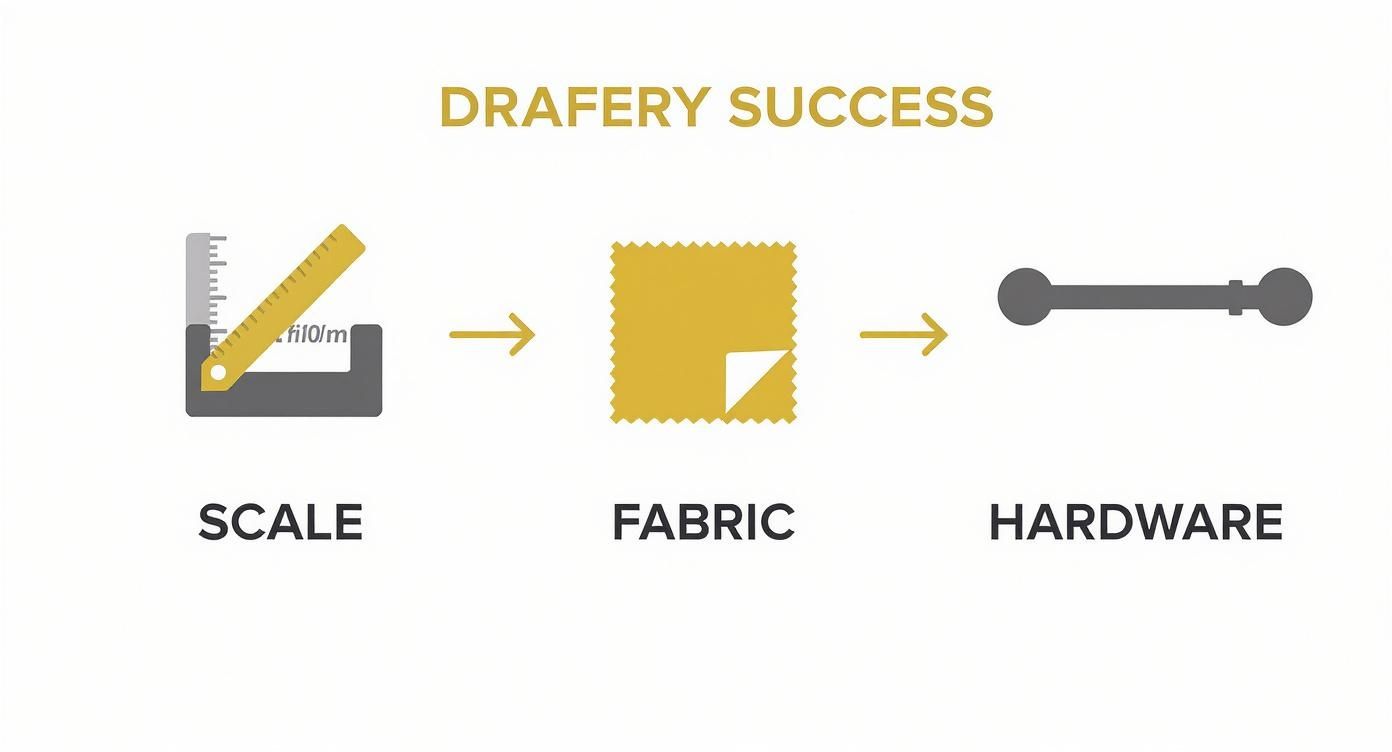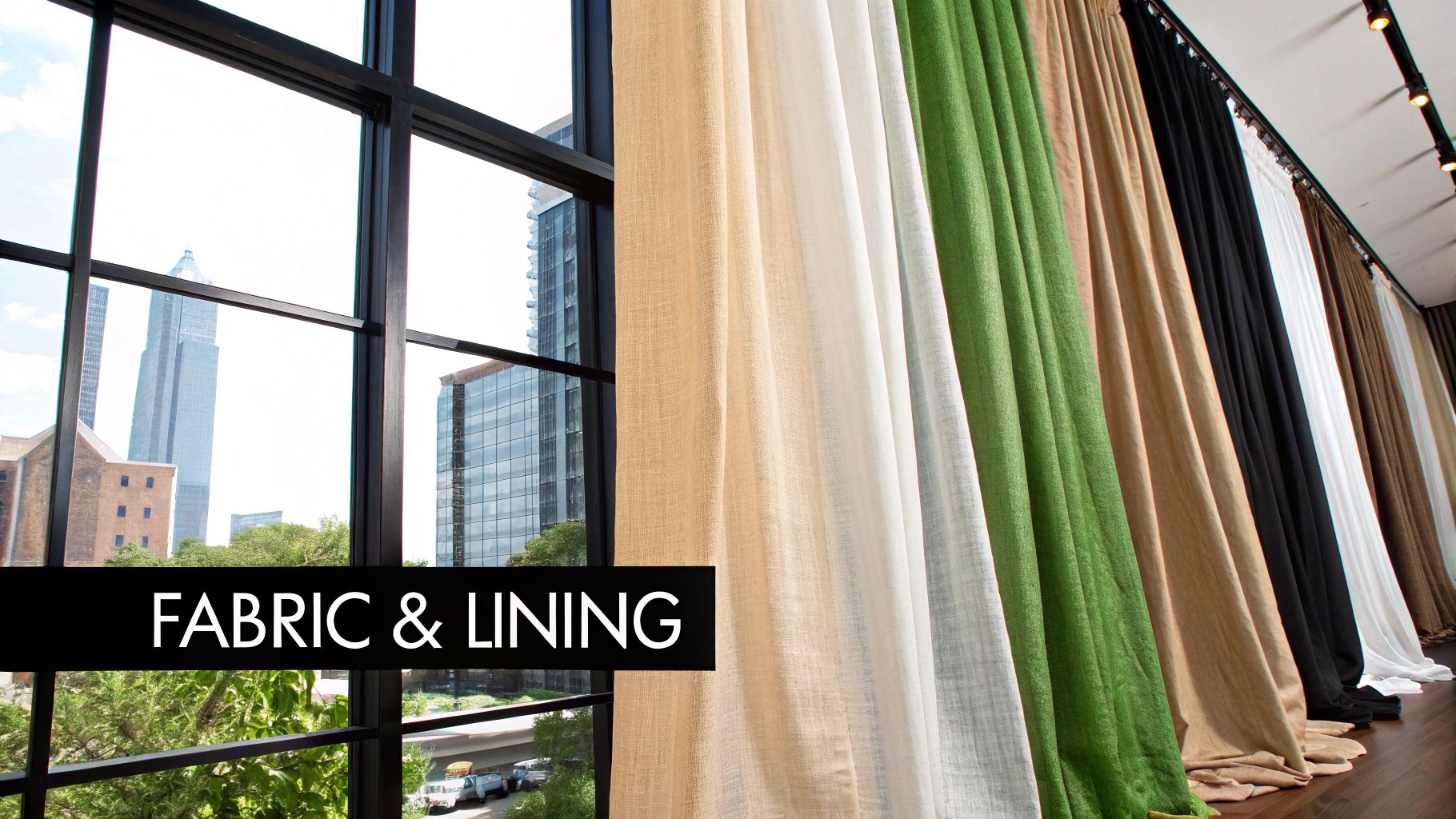
Window Drapery Ideas for Large Windows: Your Ultimate Styling Guide
Finding the right window drapery ideas for large windows can feel daunting, but the solution is simpler than you think. Success boils down to a three-part formula: mastering scale, selecting the right fabric, and choosing supportive hardware. Get these elements right, and you'll transform an intimidating architectural feature into a stunning focal point.
Large windows are a dream, flooding rooms with natural light and offering expansive views. However, they also present a unique design challenge. The wrong treatment can make a space feel awkward, but the right drapes deliver pure elegance. This guide will help you turn that challenge into a creative opportunity.
Think of your drapes as a crucial part of your room's architecture. They frame views, control light, and add texture and color that tie everything together. Let's walk through it with practical advice to help you avoid common pitfalls.
Table of Contents
- Your Guide to Dressing Large Windows
- Mastering Scale and Proportion
- Choosing the Right Fabric and Lining
- Selecting Hardware for Style and Strength
- Drapery Ideas and Inspiration by Room
- Integrating Smart Home Drapery Solutions
- Frequently Asked Questions
Your Guide to Dressing Large Windows
Before we dive in, let's look at the key elements. This table provides a quick roadmap for successfully dressing your large windows.
Quick Guide to Large Window Drapery
| Key Element | Why It's Critical for Large Windows | Expert Tip |
|---|---|---|
| Scale & Proportion | Oversized windows demand generous fabric fullness and proper height to avoid looking skimpy. | Always hang your rod high and wide—at least 4-6 inches above the frame and 8-12 inches past on each side. |
| Fabric & Lining | The sheer volume of fabric means its weight, drape, and light-filtering properties are amplified. | For insulation and a luxe feel, a thermal or blackout lining is a fantastic investment. |
| Hardware & Support | Large drapes are heavy. Standard rods will bow and fail without proper, heavy-duty support. | Use a center support bracket for any rod over 60 inches wide, and add more for every additional 30-40 inches. |
| Light & Insulation | The large glass surface is a major source of heat loss/gain and light intrusion. | Layering sheers with heavier drapes gives you ultimate flexibility for light control and privacy day or night. |
Getting these four pieces right is the foundation of a beautiful and functional window treatment. Now, let's talk about what to avoid.
Common Mistakes to Avoid
Many homeowners make a few key errors when choosing drapery for large windows. Knowing them upfront can save you time, money, and frustration.
- Undersized Panels: Drapery that isn't full enough looks cheap. For a luxurious look, your fabric should be at least twice the width of your window.
- Weak Hardware: A standard curtain rod will sag under the weight of long drapes. Investing in a heavy-duty rod and proper support brackets is essential.
- Incorrect Length: Drapes that are too short—"high-waters"—make the room feel smaller. At a minimum, they should just graze the floor for a clean, tailored look.
The single biggest mistake is skimping on size. For large windows, generosity in your fabric and real strength in your hardware are the absolute foundations of a successful design.
By keeping these principles in mind, you can confidently select treatments that are both beautiful and perfectly functional.
Mastering Scale and Proportion
When it comes to window drapery ideas for large windows, getting the scale right is the most important rule. Think of your drapery as a grand frame for your view. If the drapery is too small, it makes even a stunning window look awkward.
When you get the scale right, the whole room feels more luxurious. The trick is to think bigger than the window itself. By extending drapery beyond the glass, you create an optical illusion that makes both the window and the room feel grander.
This process boils down to three core steps: getting the scale right, picking the perfect fabric, and installing hardware that can handle the job.

It’s helpful to see how each step builds on the last. Your measurements determine how much fabric you need, and the fabric choice dictates the kind of hardware required.
Hang Your Curtain Rod High and Wide
The easiest way to get a professional, designer look is to hang your curtain rod high and wide. This simple change makes a huge difference. It draws the eye upward, making ceilings feel taller and the window seem wider.
Here are the measurements the pros use:
- Height: Install the curtain rod 6 to 12 inches above the top of the window frame. This adds a sense of height and drama.
- Width: Extend the rod 8 to 15 inches past the window frame on each side. This gives your curtain panels a place to rest when open, so they don't block the view.
A common mistake is mounting the rod right on the window frame. It seems logical, but it makes the window look smaller and blocks a surprising amount of light.
Calculate Fabric Fullness for a Luxurious Look
Fabric fullness is the secret to avoiding skimpy-looking curtains. It’s the total width of your curtain panels compared to the width of your window. Not having enough fabric quickly cheapens the look.
For a rich, pleated effect, you need plenty of fabric. A good rule of thumb is to aim for a total fabric width that is 2 to 3 times the width of your window.
- Standard Fullness (2x): This provides a classic, tailored look suitable for most styles.
- Deluxe Fullness (2.5x): This is richer and more luxurious—perfect for a formal living room or master bedroom.
- Ultra Fullness (3x): For a dramatic, opulent feel, this is your go-to, especially with sheer fabrics in grand spaces.
Choose the Perfect Drapery Length
The last piece of the scale puzzle is getting the length just right. The perfect length connects the window treatment to the floor, grounding the design. Curtains that are too short can throw off a room's balance.
Here are the three most popular and stylish options for length:
- The Float: Drapes hang about a half-inch above the floor. This practical choice is great for busy areas, as the hems stay clean.
- The Kiss: Panels just barely touch or "kiss" the floor. This creates a clean, custom look popular in modern homes.
- The Puddle: The fabric extends onto the floor by 2 to 6 inches, creating a soft "puddle." This romantic style is best for low-traffic areas and luxurious fabrics like velvet.
Choosing the Right Fabric and Lining
The fabric you choose sets the mood of the room. With large windows, the sheer volume of material has a huge impact on style, light, and even energy bills. Let's walk through how to pick fabrics and linings that look fantastic and solve common large-window challenges.
Think of fabric as the personality of your window treatment. A light sheer creates a dreamy vibe, while heavy velvet adds drama. The key is to match the material's function to your room's needs.

Fabric Types for Every Function
Different fabrics serve different purposes. Here's a breakdown of popular choices based on what they do best.
- Sheers (Voile, Organza): Lightweight fabrics that soften daylight without blocking your view. They add privacy and create a breezy feel, making them an ideal base layer.
- Linens and Cottons: For a relaxed, natural look, these fibers are perfect. Linen and cotton blends offer a beautiful, soft drape and fit well in casual, modern, or coastal designs.
- Velvets and Silks: For making a statement, these are your go-to materials. Velvet is an amazing insulator and sound dampener, adding luxury and warmth. Silk brings a luminous sheen that feels elegant.
- Synthetics (Polyester, Blends): Polyester is incredibly durable, resistant to fading and wrinkles, and often more affordable. It’s a smart choice for sunny or high-traffic areas. For a deeper look, explore our comprehensive guide to curtain cloth types.
The Power of the Right Lining
Lining is the unsung hero of high-quality drapery. For large windows, it's non-negotiable. It dramatically improves both the look and performance of your curtains.
Think of lining as the foundation of your drapery. It adds structure, protects the main fabric from sun damage, and provides critical light control and insulation.
Here’s a look at the three main types of lining:
- Standard Lining: Usually cotton or a poly-cotton blend, this lining adds body and weight, helping drapes hang uniformly and protecting the face fabric from fading.
- Thermal Lining: A fantastic investment for large windows, which are a major source of heat loss. A thermal lining provides an insulating barrier, helping keep your home comfortable and energy costs down.
- Blackout Lining: Perfect for bedrooms or media rooms, a blackout lining blocks up to 99% of outside light. It also offers excellent thermal and noise-insulating properties.
Using Patterns and Colors on a Grand Scale
When working with a canvas as large as a floor-to-ceiling window, your approach to color and pattern must be intentional. A pattern charming on a small swatch can become overwhelming on a massive panel.
Here are a few rules for success:
- Go Big with Patterns: If you love patterns, choose a large-scale design. Small, busy patterns can look chaotic from a distance. A bold, oversized print makes a confident statement.
- Embrace Solid Colors: Solid-colored drapes are a timeless choice. They create a serene backdrop that lets other elements in the room shine. Add interest with a textured fabric like slub linen or soft velvet.
- Consider the Room's Palette: Match drapes to the wall for a seamless look that can make a room feel larger. A contrasting color turns the window into a dramatic focal point.
Selecting Hardware for Style and Strength
When dressing large windows, your hardware is more than a finishing touch—it's the backbone holding the look together. A standard rod lacks the muscle for the weight and span of drapes for grand windows.
Picking the right hardware is about balancing strength and style. You need a system that won’t sag and works smoothly, while also elevating your design.
Heavy-Duty Rods and Essential Supports
For any window wider than 60 inches, a heavy-duty drapery rod is a must. These rods are thicker—typically 1 1/8 inches or more in diameter—to prevent bowing under the fabric's weight.
To maintain a straight line, center support brackets are essential. A sagging curtain rod cheapens the look of any room.
Here’s a simple rule:
- For any rod over 60 inches, use a center support bracket.
- Add another bracket for every additional 30-40 inches of width.
- This ensures weight is distributed evenly, preventing sag and protecting your rod and wall.
Remember, fabrics like velvet or lined linen add up quickly. Investing in proper support from day one saves you from headaches later.
Traverse Rods for Effortless Operation
While you can pull standard curtains by hand, a traverse rod system is a more elegant solution for wide windows. These systems use an internal track with carriers to glide drapes open and closed with a cord or wand.
This mechanism is a game-changer for large drapery:
- Smooth Functionality: Move heavy panels with almost no effort.
- Perfect Pleats: Evenly spaced carriers keep pleats crisp and uniform.
- Longevity: Reduced handling of the fabric minimizes wear and tear.
Matching Hardware to Your Home Decor
Beyond strength, your hardware should complement your room’s style. The finish, shape, and finials can pull the entire look together.
- For a Modern Look: Choose sleek track systems or slim metal rods in matte black, brushed nickel, or brass. Minimalist end caps work best.
- For a Traditional Style: Select thicker wood or metal rods with decorative finials. Finishes like antique bronze or dark wood add a timeless, elegant feel.
The Ultimate Convenience: Motorized Drapery
For the ultimate blend of luxury and convenience, especially for tall or hard-to-reach windows, motorized drapery rods are an incredible solution. Open and close your drapes with a button, voice command, or pre-set schedule. This smart home tech adds sophistication and practicality.
Drapery Ideas and Inspiration by Room
Let’s move from theory to reality. Here's your practical lookbook for dressing large windows room by room, showing how scale, fabric, and hardware come together.
Homeowners are increasingly investing in window treatments. According to Allied Market Research, the global market for curtains and blinds is projected to reach nearly $44.58 billion by 2035, up from $26.1 billion in 2025. This shows how much we value solutions that are both beautiful and useful. You can read more about these market trends if you're curious.

For the Living Room Grand Picture Window
A large picture window is a living room's star attraction. The goal is to enhance it, not hide it. Stationary side panels are a fantastic solution. They act as decorative accents, adding softness, color, and texture without blocking the view.
- Fabric Choice: A medium-weight fabric with a beautiful drape, like a linen blend or faux silk, works wonders.
- Hardware Tip: A decorative rod extending well past the window frame makes the window feel even bigger and ensures panels don't block light.
For the Bedroom Wall of Windows
For a wall of windows in a bedroom, you need to balance natural light with privacy and darkness for sleep. Layering is your secret weapon. A dual-layered approach on a double curtain rod offers ultimate flexibility.
- Inner Layer: Hang sheer curtains on the rod closest to the glass. They soften sunlight and add daytime privacy while keeping the room bright.
- Outer Layer: On the front rod, hang high-quality blackout drapes. Rich fabrics like velvet or thermal materials are perfect. They block light and insulate the room from noise and temperature changes. Joey’z Shopping has a beautiful collection of blackout curtains perfect for this.
This two-in-one strategy is a game-changer. You get the soft feel of sheers for daytime and total darkness for a restful night's sleep.
For the Dining Room with Tall Windows
Tall windows in a dining room invite a warm, intimate atmosphere. Floor-to-ceiling drapes in a rich, textured fabric are ideal. You could choose a subtle, large-scale pattern or a solid color that complements your decor.
- Fabric and Length: Heavy cotton, brocade, or lightweight velvet can add instant luxury. Let the drapes "kiss" the floor for a clean, tailored finish.
- Styling Tip: Consider elegant tie-backs to hold drapes open, creating a graceful sweep that frames the windows. Explore the Joey'z Shopping curtains collection for perfect styles.
Integrating Smart Home Drapery Solutions
The future of window treatments blends timeless style with seamless convenience. Smart technology is a game-changer for grand-scale windows that are tall, wide, or hard to reach. It removes the effort from managing light and privacy.
Imagine opening your drapes with a click, a voice command, or a pre-set schedule. Motorization makes this a reality, adding everyday luxury and making your home more functional.
The Benefits of Automation
Automated drapery offers more than convenience. It can boost your home's security by making it look occupied when you're away. It also helps protect your furniture, art, and flooring from harsh UV rays by closing automatically during the brightest parts of the day. To learn more, it helps to understand what a home automation system is.
How Smart Drapery Systems Work
Motorized drapes are surprisingly straightforward to integrate. These systems are designed to work with popular smart home platforms.
- Motorized Rods and Tracks: A specialized rod or track houses a whisper-quiet motor.
- Multiple Control Options: Operate them with a remote, wall switch, smartphone app, or voice commands.
- Smart Home Integration: They connect easily with Amazon Alexa, Google Assistant, and Apple HomeKit, allowing commands like, "Hey Google, open the living room drapes."
At Joey'z Shopping, we believe elegant design and intelligent living go hand-in-hand. Smart drapery is a perfect example of how modern technology can elevate both the beauty and functionality of your home.
Frequently Asked Questions
How can I make my large windows feel cozier?
The short answer is to use rich textures and layering. Heavy fabrics like velvet, wool blends, or lined linen add physical and visual warmth, grounding the space. Pairing sheers for daytime with substantial drapes for the evening creates a cozy, intentional design that makes the window feel like a deliberate part of the room's architecture.
Are curtains or blinds better for large windows?
Often, the best approach is to use them together. Curtains are unmatched for adding softness, color, and luxury. Blinds or shades offer precise control over light and privacy. A popular and functional strategy is to layer drapery panels over cellular shades or wood blinds, giving you the best of both worlds: clean light-filtering and stylish insulation.
What is the biggest mistake to avoid with drapery for large windows?
The single biggest mistake is using drapery and hardware that are too small. Curtains need a fabric width at least twice the window's width to look full and luxurious. Just as importantly, flimsy hardware will sag and cheapen the entire look. Always invest in a sturdy rod with enough support and ensure your drapery panels are long enough to at least kiss the floor.
At Joey'z Shopping, we believe every window deserves a beautiful treatment, no matter its size. Explore our extensive collection to find the perfect drapery and hardware to bring your vision to life.
Find your perfect style at https://joeyzshopping.com
